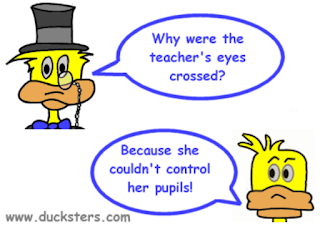Walk Throughs and Best Practice
Folder of feedback on unit development by subject, click Here
Walk Through and Best Practice at Global Jaya,
Earlier
this month we did walk throughs, visiting Science and English classes. We saw
consistent use of Learning Objectives, we also saw command terms or thematic or difficult words posted
and displayed on the walls. This is exemplary practice, as the command terms
play an important role in:
Developing learning objectives,
using command terms in Learning Objectives
(Before teaching)
Teaching how to apply command terms
and skills to students (During teaching )
Assessing skills and learning using
command terms in assessment (Assessment After teaching)
Supporting research and theory
The use of the important command terms and key terms posted
in the room is a good practice that can be shared. This is sometimes known as
“Word Walls". For more see http://www.readingrockets.org/strategies/word_walls
For using
command terms to develop Lesson Objectives see GJS MYP DP Teacher Guide P 12 https://drive.google.com/file/d/0B41f9T_FZso4VGc0ajhzZHQ4NTA/view
Displaying and teaching a list of command terms or thematic
or difficult words before a unit and using them throughout is a good
differentiation scaffold for language learners. (Powell) Making the
difference.
There
is a copy of Making the difference in the IB office. Also, the Co-Author is
visiting GJS in August for a Cognitive Coaching workshop for leadership, HODs
and CL.
Action to be taken
Consider this feedback
with the unit reflection: before, during and after. Does this and can this
apply to other units? Is this something we do intuitively that can be
formalized in the unit plan and lesson planning? Is it already formalized and
can other subjects learn from us? How can we teach this words before the unit,
during instruction, and during reflection after assessment to weave these
through the unit?
Teachers can
include the teaching of command terms in
the unit planner under the section in
the “differentiation” section , the section for “learning process”, or
both.
Coordinate with
the department the display of command terms in all rooms for the start of the
school year.
 |
| Command Terms in Science |
Walk Through and Best Practice at Global Jaya, Mid March Walk Throughs
Feedback on walkthroughs has been provided to departments and HOD's. We saw a lot of good practice during the walk through and we would like to provide teachers the opportunity to share and broaden ‘best practice’. Three things in particular we saw were:
· Use of command terms in lesson objective, in class instruction, and in class displays.
· Use of student choice of topic or product
· Use of peer assessment and self-assessment
Self-Assessment and Peer -Assessment
One notable strategy that we saw was Self-Assessment and Peer Assessment. We observed students sharing papers and giving feedback on each. This is an important part of ATT Assessment for Learning. AFL deeply involves students in the process of assessment. The goal of assessment it “To build a bridge between teaching and learning” ("Introduction: teaching informed by assessment").
Figure 1. “Memes Meme: Dad That Kid Said My Artwork Sucked” Me.me, me.me/i/dad-that-kid-said-my-artwork-sucked-how-to-give-7335859. Accessed 18 Mar. 2017.
Supporting research and theory
Peer assessment and Self-assessment are important parts of Assessment for Learning. For peer and self-assessment, see the MYP DP Teacher guide for more on involving students in assessment on P 47 "Seven strategies for assessment" ("GJS MYP-DP Teacher Guide"). These are two good strategies that can be shared.
The philosophy of assessment for learning at GJS can be found on p14 of the GJS MYP DP Guide https://drive.google.com/file/d/0B41f9T_FZso4VGc0ajhzZHQ4NTA/view ("GJS MYP-DP Teacher Guide").
For ways to promote peer feedback such as ‘two stars and a wish’ ‘Plus minus’ what next’ and ‘traffic lights’ see Assessment for learning http://www.assessmentforlearning.edu.au/professional_learning/peer_feedback/peer_strategies_enhance.html ("Strategies to Enhance Peer Feedback").
Action To be taken with this feedback
Unit Reflection Section of the planner
Consider this feedback with the unit reflection: before, during and after. Does this and can this apply to other units? Is this something we do intuitively that can be formalized in the unit plan and lesson planning?
ATL Section of the planner
You can include peer assessment and self-assessment in the learning process section of the unit planner.
Learning Process Section of the planner
The process of peer assessment can be included in the learning process section of the unit planner.
Work cited
“GJS MYP-DP Teacher Guide.” GJS MYP-DP Blog, Global Jaya IB Office, 20 Jan. 2017, drive.google.com/file/d/0B41f9T_FZso4VGc0ajhzZHQ4NTA/view. Accessed 18 Mar. 2017.
ml. Accessed 18 Mar. 2017.
Unit Reflection Section of the planner
ATL Section of the planner
Learning Process Section of the planner
4 ways to increase student engagement
What a successful graduate has to say:
For Teachers: 4
Tips to Engage Your Students (These Worked for Me!)
Throughout all four years at Big Picture, I felt valued, and I felt like my
voice mattered. From my experience at Big Picture -- and from knowing what
engaged me in my learning -- here are four practical tips that you can adopt to
engage your students.
1. Create a close
relationship with your students.
At Big Picture, we called our teachers by their first names. It was so much
easier for me to ask a teacher a question when I considered that teacher as a
friend. To create a bond with your students, engage them in personal
conversation. Before my classes would start, we would usually sit and talk
about anything we wanted to, and our teacher would be right in the middle of
the conversation. By drawing closer to your students and closing the distance
between the terms friend and teacher, you'll create a space
where your students will feel comfortable and safe to interact with you. They
will be less shy when asking you a question, and they will turn in better work
if they see you as someone they trust and whose opinion they value.Related Resource: Advisory: 22 Ways to Build Relationships for Educational Success







Comments
Post a Comment